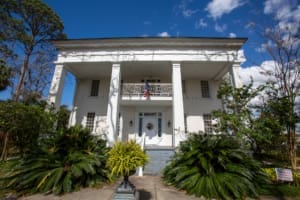On September 27, 1864, Union troops led by Brigadier General Alexander Asboth struck the small Northwest Florida City of Marianna. The result was a bloody battle remembered today as The Battle of Marianna.

The battle developed when Southern Union sympathizers brought word to General Asboth that Federal prisoners were being held at Marianna and plans were underway to fortify the town. Leaving Fort Barrancas at Pensacola, Asboth led 700 mounted men through six modern Florida counties. He reached Marianna on September 27, 1864.
Commanded by Colonel Alexander Montgomery of the regular Confederate army, an outnumbered force of Southern militia, reserves, volunteers, wounded soldiers home on leave and a few regulars tried to defend against the attack.
Asboth and his men made a bold attack up the main street of the city while a flanking party moved in behind Montgomery and his defenders. The fighting moved up Lafayette Street from the edge of town as Asboth drove back the commander and his mounted forces, only to charge right into an ambush prepared by the men of the Marianna Home Guard and local volunteers who joined in when the news of the Federal approach reached the city.
Asboth was severely wounded, along with “nearly every officer and man” at the head of his column. His principal regiment, the 2nd Maine Calvary, suffered its greatest losses of the war that day. Unfortunately for Marianna’s defenders it was not enough.
The main body of the Union force turned on the Marianna Home Guard with a fury the Confederate firing from along the southern edge of the street was driven down a steep hill and virtually all were killed, wounded, or captured.
The local men fighting from the north side of Lafayette Street fell back to St. Luke’s Episcopal Church; where the battle degenerated into a brutal fight in the cemetery behind the church. The battling forces fired at each other from just yards away. Even after the main body of the Home Guard surrendered, Union troops fired a volley into their ranks. Seeing this, Confederates firing from the windows of the church and two nearby homes refused to surrender and continued to fight.

In the end, the church and both homes were burned to the ground, four men and boys died in the flames.
By the time the battle was over, both sides had been severely bloodied, more than 25% of the male population of Marianna had been killed, wounded or captured.
Brochures for self-guided walking tours of the Marianna Battlefield are available at the historic Russ House and Visitor Center!
Courtesy of Author/Historian Dale Cox


